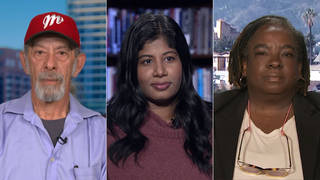
According to a major expose in The New York Times, federal agencies under the Bush administration–from the State Department to Agriculture to the Transportation Security Administration–have been producing hundreds of pre-packaged TV segments that have been broadcast on local stations as real news. We speak with John Stauber of PR Watch, which has been tracking the rise of government and corporate-produced news for years. [includes rush transcript]
A new report by the FBI and Department of Homeland Security has found that al Qaeda may have already discussed plans to hijack charter planes, helicopters and other general aviation aircraft because they are less guarded than commercial airliners.
The internal report–obtained by The New York Times–detailed particular vulnerabilities in what it called “the largely unregulated” area of general aviation. The report makes clear that counterterrorism officials still consider the aviation industry to be a prime target for major attacks.
While the news grabbed headlines this past weekend, the Transportation Security Administration has been spinning a very different story. The TSA has been putting out video news releases that have been broadcast on local news stations as real news. This is an example.
- Video News Release produced by the Transportation Security Administration.
That was a video news release featuring a “reporter” who is actually a public-relations professional working under a false name for the Transportation Security Administration. Yesterday, The New York Times featured an extensive front-page investigation detailing the extent that pre-packaged news releases–produced by the federal government–are being used by television stations all across the country.
The article reports that at least 20 federal agencies–including the Defense Department and the Census Bureau–have distributed hundreds of television news segments in the past four years. Many were then broadcast on local stations without crediting the government as the source of the information.
The article goes on to state that “the administration’s efforts to generate positive news coverage have been considerably more pervasive than previously known. At the same time, records and interviews suggest widespread complicity or negligence by television stations.” Later the article says that “some reports were produced to support the administration’s most cherished policy objectives like regime change in Iraq and Medicare reform…They often feature quote, unquote “interviews” with senior administration officials in which questions are scripted and answers rehearsed. Critics are excluded as are any hints of controversy, waste or mismanagement.”
This is another example of a video news release produced by the State Department.
- Video News Release produced by the State Department.
We go to Madison, Wisconsin to speak with John Stauber–whose organization PR Watch has been tracking the rise of government and corporate-produced news for years.
- John Stauber, Executive Director of the Center for Media and Democracy, publishers of PR Watch.
Transcript
AMY GOODMAN: The T.S.A. has been putting out video news releases that have been broadcast on local news stations as real news. Here is an example.
JENNIFER MORROW: For most Americans, New Year’s Eve simply marks the end of another year, but for the Transportation Security Administration, it represents another success in the drive to strengthen aviation security and restore America’s confidence in air travel. At every airport, the evidence of new and better security, a top-notch workforce of federal security screeners, more bomb sniffing dogs on patrol and now screening of checked bags for explosives.
SPOKESPERSON: Less than a year ago, T.S.A. had only a handful of employees to get the job done. Today more than 20,000 screeners are checking bags at over 400 airports in America, making sure they’re safe before they’re loaded onto planes.
JENNIFER MORROW: It’s one of the most remarkable campaigns in aviation history. Thousands leaving impressive careers and good jobs to take up the front lines in the war against terrorism.
WOMAN: I have experienced flying in and out of national for a while, and yes, it is much better. And I feel very good about traveling today.
JENNIFER MORROW: The T.S.A. met a November deadline to position highly trained passenger screeners at security checkpoints. And now at the end of the year, the latest improvement, making sure every piece of checked baggage is screened for bombs.
SCREENER: Every bag will be x-rayed and screened. We deal with the ETD and the EDS technology. If there’s a case where there’s an explosive device in a bag it, will be retrieved and detected before it boards the aircraft.
JENNIFER MORROW: The T.S.A. will use electronic equipment to screen bags at all 429 U.S. airports. And where necessary, dogs, hand searches and bag-matching techniques to get the job done, all of it to insure that every bag is safe before it gets loaded onto a plane, and just as importantly, to give Americans who fly another reason to have peace of mind. This is Jennifer Morrow reporting.
AMY GOODMAN: That was a video news release featuring a reporter who is actually a public relations professional working under a false name for the Transportation Security Administration. Yesterday, The New York Times featured an extensive front page investigation detailing the extent that prepackaged news releases produced by the federal government are being used by television stations all across the country. The article reports that at least 20 federal agencies, including the Pentagon and the Census Bureau, have distributed hundreds of television news segments in the past four years. Many were then broadcast on local stations without crediting the government as the source of the information. The article goes on to state, quote, “The administration’s efforts to generate positive news coverage have been considerably more pervasive of than previously known. At the same time records and interviews suggest widespread complicity or negligence by television stations.” Later, The New York Times piece says, quote, “Some reports were produced to support the administration’s most cherished policy objectives, like regime change in Iraq and Medicare reform.” They often feature, quote, unquote, “interviews” with senior administration officials in which questions are scripted and answers rehearsed. Critics are excluded as are any hints of controversy, waste or mismanagement. Let me bring you now another example of a news release, but we’re going to do this after the break. Coming up, we’ll see a news release that came out from the State Department around Iraq. This is Democracy Now! We’ll go to that after this break.
[break]
AMY GOODMAN: Our guests are Pulitzer Prize winning reporter, Laurie Garrett. She has just quit Newsday, issuing a scathing memo about the state of the media today. On the phone with us, we’re joined by John Stauber of P.R. Watch. But let me bring you the second of these VNRs, that’s video news releases, that local newscasts are using around the country. This one was produced by the State Department.
REPORTER: The televised images from Baghdad prompted celebrations from Iraqi Americans all across the United States. They seemed to revel in the collapse of Saddam Hussein’s regime, as much as they did in Baghdad. In suburban Detroit, hundreds of Iraqi Americans marched triumphantly through the streets. The community of Dearborn is home to America’s largest Arab community. On Warren Avenue people chanted, “No more Saddam,” as they honked horns and waved Iraqi and American flags.
IRAQI AMERICAN 1: We love the United States! We love America! They help us!
IRAQI AMERICAN 2: Yes!
REPORTER: In this Kansas City cafe, Iraqi Americans watch the historic events on TV.
IRAQI AMERICAN 3: I’m very, very happy. I said, thank you, Bush. Thank you, U.S.A. I love Bush, I love U.S.A., because they do that for Iraqi people’s freedom.
REPORTER: At the Arab American Center in San Jose, California:
IRAQI AMERICAN 4: To see him toppled and destroyed, it’s very gratifying. It’s very gratifying to all of the Iraqis.
REPORTER: At this Mid-Eastern market in Denver, Colorado:
IRAQI AMERICAN 5: I never heard anybody who said he wants to see Saddam stay so they all want Saddam to go.
REPORTER: For Iraqis living in the U.S., the nearly quarter century-long nightmare in their homeland is now drawing closer to the end.
AMY GOODMAN: A video news release produced by the State Department. On the phone us with from Madison, Wisconsin, John Stauber whose organization, P.R. Watch, has been tracking the rise of government and corporate produced news for years. Welcome to Democracy Now!, John.
JOHN STAUBER: Hi, Amy. It’s a pleasure to be on.
AMY GOODMAN: It’s good to have you with us. This is a major piece in the Times. They have got the frames of video news releases front and center in yesterday’s New York Times headline, “Under Bush, A New Age Of Prepackaged News.” You have been following this kind of, I think you could call, selling, whether it’s corporations or government, for a long time. Respond.
JOHN STAUBER: I was absolutely elated to see The New York Times front page coverage with the inside spread. I would urge everyone watching or listening to read that article. We link to it off of our website at prwatch.org. In the more than ten years that I have been investigating and reporting on the widespread use of public relations as news, there’s never, ever been a story like this. This widespread use of fake news, we’re talking thousands of stories a year. This is a billion dollar sub-industry of the P.R. industry has been going on for 20 years, and this is the first mainstream media expose of any length and depth about it.
AMY GOODMAN: So let’s get into how these end up on local newscasts.
JOHN STAUBER: Well, it’s like this. First of all, we’re talking about fake news. These are news stories done by journalists, but these are journalists who now work for public relations firms employed by the State Department, employed by pharmaceutical companies, and they’re producing news stories, video news releases, which are provided free to TV networks and TV stations, and are then aired by TV networks and news producers as if they were news, often as if they were produced locally by the station. And what this is, actually, is propaganda, because these are not news stories. They look like news stories, but they have a bias in favor of a political program or an ideology or a product. And the networks and stations that air these, and we’re talking about thousands of these produced a year, are engaging simply in plagiarism and fraud, fraud perpetrated on their viewers, saying this is news when it’s not news. It’s all provided. To follow up on some critical points that Laurie was making earlier, what’s going on here is that TV news directors and networks are not only passing on fake news and propaganda, but that so-called “news hole,” all of that time that could be used to actually report news is being filled up with this fake news and propaganda. And The New York Times piece really, really puts the wood to the Bush administration for their massive spending, a quarter of a billion dollars in just the last four years on P.R. spin and propaganda. You know, we need a full scale investigation of how that money has been spent, but actually, that’s just the tip of the iceberg, when you consider that most of these are coming from corporations.
AMY GOODMAN: Couldn’t you also argue that people would have gotten a sense of where these were coming from earlier, if the actual newscasts didn’t look a lot like this anyway? I mean, you have a Pentagon report where they’re all saying, “Welcome, America,” without any countering point of view. Isn’t that often what we got anyway, and it really is hard to distinguish. This is what’s frightening. The VNR, the video news release from the Pentagon, from a standard report, and maybe that’s even worse, a report that so-called was produced independent of the government. Laurie Garrett.
LAURIE GARRETT: One of the things that happens a lot in the local news is, since — again, they have to have a high profit return on their local newscast, and that’s hard to do if you are spending a lot of money sending reporters out to do slick, well-produced stories. But you could take a produced story like this, the one you just saw about Iraq or the one about the Transportation Safety Agency, and you can pull out the audio of the fake reporter and put in audio of your own reporter, voicing over the same footage with basically the same slant and the same construct of the editing of the video, and it sounds like, and if you are sitting there in Memphis, Tennessee, watching this on your TV, or in Oakland, California, or wherever you might be, to you, it seems like a locally produced, legitimate news story. And this is true both for things coming from the government and also it has been true for a long time, for corporate spin releases on specific corporate products, especially the pharmaceutical industry.
AMY GOODMAN: Looking at the piece inside, they have a photograph of Karen Ryan, the so-called reporter in several of the government produced segments. “As she cringes at the phrase, 'covert propaganda.' These are words for dictators and spies, and yet they have attached themselves to her like a pair of handcuffs,” the Times writes. “Not long ago, Ryan was a much-sought-after so-called reporter for news segments produced by the federal government. A journalist at ABC and PBS, who became a P.R. consultant, Ryan worked on about a dozen reports for seven federal agencies in 2003 and 2004. She was surprised by the number of stations that were willing to run her government segments without any editing or acknowledgement of origin. As proud as she says she is of her work, she did not hesitate even for a second when asked if she would have broadcast one of her government reports if she were a local news director. She said, 'Absolutely not.'” John Stauber.
JOHN STAUBER: Well, to use her own words this is covert propaganda, and the fact that when she puts on her journalist hat, she says, “I wouldn’t air the fake news that I produce through my P.R. firm,” really underlines that. Karen Ryan has sort of become the poster child over the last year, of this problem, but there’s — here’s what’s happening. The people like Karen Ryan, the public relations professionals who usually, by the way, come out of journalism and go into P.R. because there’s a lot more money to be made, say, “Hey, you know, we’re P.R. people. Of course, we produce these. It’s up to the news directors and producers to label them as provided footage.” But they know. They know perfectly well that virtually no news director in this country, no producer at a TV station in this country, labels this as provided footage. They should, but if they label that footage, and they said, “This is a video news release provided by the State Department,” “This is a video news release provided by the Transportation Security Administration,” “This is a video news release provided by Monsanto,” that would destroy it. That would expose it. So, what’s going on here is that the public relations industry, the billion dollar industry of video news releases knows that the TV news directors and producers are not going to label these, and there’s a very simple solution here. Label it. They should be labeling it. The Radio, TV, and News Director’s Association has for decades now turned a blind eye to this, and it clearly violates their ethics code. In The New York Times article, they’re muttering about strengthening their ethics code, but that won’t matter, because they don’t care. There’s so much money to be made or saved, if you will, by replacing real news on TV with fake news, that this will continue to be a widespread problem unless there’s a mobilization of outraged news viewers who demand that the F.C.C. step in and enforce standards which would seem to indicate that this is in violation of the F.C.C. standards, and then I think the media reform movement is also going to have to figure out how to hold TV news directors and producers’ feet to the fire, because they’re not going to want to give this up. This — we’re talking billions of dollars here in producing these and in airing them instead of going out and producing real news.
AMY GOODMAN: Laurie Garrett.
LAURIE GARRET: You know, one of the things that I found, Amy and John, I’d love to know your sense of this, as well, but one of the things I found as a visiting professor at a lot of graduate journalism departments around the country over the last few years is, I have seen this disturbing trend where I will ask students in the room, “How many of you want someday to work at a major newspaper, be a Woodward or Bernstein at The Washington Post or be a network television correspondent.” A couple of hands go up. Then I look the at rest of the room. “Well, what is it you all want to do?” and they all say “public relations.” So, the lines are getting very, very blurred, even at the level of the basic training in journalism schools.
AMY GOODMAN: Well, aren’t P.R. schools and journalism schools also merging in some places?
LAURIE GARRETT: They have merged. I mean, let’s face it. And when you ask the students why public relations as opposed to journalism, often they would say to me, “Well, there really isn’t that much of a distinction, but you can make more money on the P.R. side.”
AMY GOODMAN: Well, isn’t the scandal around Jeff Gannon or whatever the guy’s name is, who was in the White House using a false name and asking puffball questions, isn’t this — how, John, would you connect this to this expose on VNRs. I mean, you have got these P.R. people who aren’t even using their own names in their reports, who are using fake names, for example, the T.S.A. so-called reporter?
JOHN STAUBER: I consider the Jeff Gannon story and scandal a major scandal, and certainly, that deserves much deeper examination than it’s gotten. But I think when we’re talking these fake news stories, it’s an even bigger scandal, and here’s why. Most Americans get most of their news, unfortunately, from television. We know that TV is the worst source to receive news. For instance, back in the first Gulf War, the Hill & Nolten P.R. firm produced 20, at least, video news releases promoting the war. No one has gotten a hold of those to examine them. A reporter from The Progressive investigated this afterwards, and the P.R. firm refused to turn them over. We also know from the University of Amherst study back then, and there have been other studies that have corroborated this with other situations since, that the American public, who watched the most TV coverage of that Gulf War, thought they knew the most, actually knew less than most people who were getting their news through newspapers, for instance, and yet were the strongest supporters of the war. So, the bottom line here is that if you are watching war on television, with all of the propaganda and video news releases that go along with it, you are actually being misinformed, and yet you’re more likely to support the war. Television is the number one source of so-called news for most Americans, and a huge proportion of that is fake news.
AMY GOODMAN: Now, isn’t this a violation of the Smith-Mundt Act after World War II, that you’re not supposed to propagandize your own population. You know, it’s why we can’t hear Voice of America in the United States?
JOHN STAUBER: Well, it would appear to be, and there are other acts, going all the way back to the 1920s where Congress has weighed in and said that in a democracy, government propaganda is inappropriate and illegal. But the government has consistently gotten around that, and both Republican and Democratic administrations and politicians have hired P.R. professionals and used spin and used propaganda, but I think the exciting thing now is that I hope this New York Times expose in the context of all of the other exposés going on and in the context of the growing media reform movement will really incite a mobilization where, through F.C.C. regulations and through grassroots mobilization, we can get rid of these video news releases.
AMY GOODMAN: I just want to bring in one thing, since we only have 30 seconds. In California, Governor Arnold Schwarzenegger also coming under criticism for producing video news releases. Last week, his communications director, Rob Stutzman defended the so-called VNR, saying it’s just like any other press release, only it’s on video.
JOHN STAUBER: Well, that would be true if the press release constituted verbatim, for instance, most of the front page of The New York Times. The difference here is that they’re handing a fake news story, and it’s being aired as a real news story. It’s not being used for background information. It’s taking the place of the news.
AMY GOODMAN: And we’re paying for it.
JOHN STAUBER: Yeah. In the case of Governor Schwarzenegger —
AMY GOODMAN: Taxpayer dollars.
JOHN STAUBER: — and the Bush Administration, that’s public money.
AMY GOODMAN: We’re going to have to leave it there. I want to thank you, John Stauber, for joining us from P.R. Watch, prwatch.org. And Laurie Garrett, thanks very much for spending the hour with us.
LAURIE GARRETT: It’s terrific.
AMY GOODMAN: Former Newsday reporter, Pulitzer Prize winning reporter, now at the Council on Foreign Relations.













Media Options